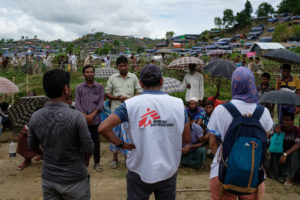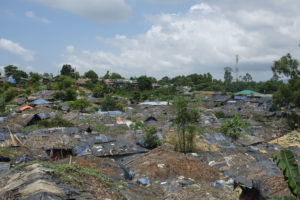The first thing that strikes you is their silence. The Rohingya are quiet, placid, and polite. They endure, accept, and hope. We hear repeatedly, stories of their men taken away, their women raped, and their villages burned. They have escaped over mountains and through rivers; sustained injuries, dehydration and malnutrition; and have finally reached a sanctuary, of sorts, looking shell-shocked and broken.
I arrived in Kutupalong to assist the Médecins Sans Frontières (MSF) emergency response. In a matter of weeks our staff increased from 200 to 1,000. We hit the ground running with extra doctors, nurses, midwives, water and sanitation experts, logisticians, and construction engineers.
Emergency response is what MSF does, and does well. We opened new health posts across the settlements, built new inpatient facilities, expanded our hospital intake, and constructed new water points and latrines. We have trained teams of community volunteers to identify the sick and refer them to our services.
My role is to measure the size of the health problem. There are some key health indicators we need to know. The most important is the crude mortality rate, which tells us the scale and severity of the emergency. By understanding the rate at which people are dying and why, we can try and prevent further similar deaths. So, we have trained our 250 community volunteers, to visit every household this week, and as well as referring anyone that’s sick, they also ask if anyone has died. This is a difficult topic to broach, so we train our teams to be gentle, polite, and sensitive. We will have our first mortality rates next week.
 We also need to understand the main health concerns in the settlement, we are training an additional team of 20 community volunteers to perform a health survey, collecting data on smartphones. This will give us an idea of the main health conditions and diseases currently affecting the population. In addition, we will measure vaccination coverage rates, malnutrition rates, and health-seeking behaviour practices which will help us to understand the main disease risks so we can target our interventions more appropriately.
We also need to understand the main health concerns in the settlement, we are training an additional team of 20 community volunteers to perform a health survey, collecting data on smartphones. This will give us an idea of the main health conditions and diseases currently affecting the population. In addition, we will measure vaccination coverage rates, malnutrition rates, and health-seeking behaviour practices which will help us to understand the main disease risks so we can target our interventions more appropriately.
Finally, we need to understand how many people are here so that we can provide enough drugs and medical services, target our water and sanitation activities appropriately, and help camp management to provide enough food and shelter. To do this, we are using satellite imagery and working with teams at the University of Salzburg to count and categorise shelters in each image. To convert this into a population estimate, our community volunteers visit a random sample of shelters and collect information on smartphones with GPS capacity to count the number of people living under each type of shelter.
 We scatter all over the Kutupalong and Balukhali settlements, gathering data. I accompany some volunteers to the south-west corner of the Kutupalong settlement. The trek is exhausting. Apart from the heat and the humidity, the terrain is hilly with uneven trails and precarious bridges, sometimes made of a single bamboo pole that I struggle to cross without assistance but the Rohingya traverse without batting an eyelid.
We scatter all over the Kutupalong and Balukhali settlements, gathering data. I accompany some volunteers to the south-west corner of the Kutupalong settlement. The trek is exhausting. Apart from the heat and the humidity, the terrain is hilly with uneven trails and precarious bridges, sometimes made of a single bamboo pole that I struggle to cross without assistance but the Rohingya traverse without batting an eyelid.
Without the GPS receiver, I would be hopelessly lost. The GPS is directing us to a randomly selected shelter, but it doesn’t always tell us the best route. I find myself in a “shitting field”, an area set aside for defecating while latrine construction is underway. My team burst out laughing and take a different route. But I’m so far ahead; this is the Kutupalong version of the lorry driving into the bridge! I have no choice but to continue.
I turn a corner, climb a hill, and catch my breath. Suddenly, I have a panoramic view of this corner of the settlement. There are shelters as far as the eye can see, precariously balancing on hilly terrain and providing minimal protection against the torrential rain that comes every few days. I wonder what the future holds for the Rohingya. This population has endured so much and continues to persevere, with incredible resilience. If they survive this current chapter of their lives, will they finally get the status and identity they yearn?
Please support The BMJ‘s Christmas 2017 appeal for Médecins Sans Frontières, bringing medical volunteers to the world’s neediest people: donate at www.msf.org.uk/bmj
£123 could pay for a blood transfusion for three people
£65 could buy a stretcher to help move an injured person to safety
£54 could provide antibiotics to treat 40 war wounded people
Donate online: www.msf.org.uk/bmj
Donate by phone: 0800 408 3897 (UK only)
Ruby Siddiqui is an epidemiologist who has worked with Médecins Sans Frontières for over nine years and has responded to emergencies in Haiti, the Philippines, South Sudan and Uganda. Most recently, Ruby joined the emergency team in Cox’s Bazar responding to the influx of Rohingya refugees fleeing Myanmar into Bangladesh.
Competing interests: None declared.
Photos: credited to Antonio Faccilongo.
Photo 1: MSF community health workers explain how to prevent the spread of disease and hand washing practices.
Photo 2: A view of the roofs in Kutupalong, one of the main pre-existing settlements.
